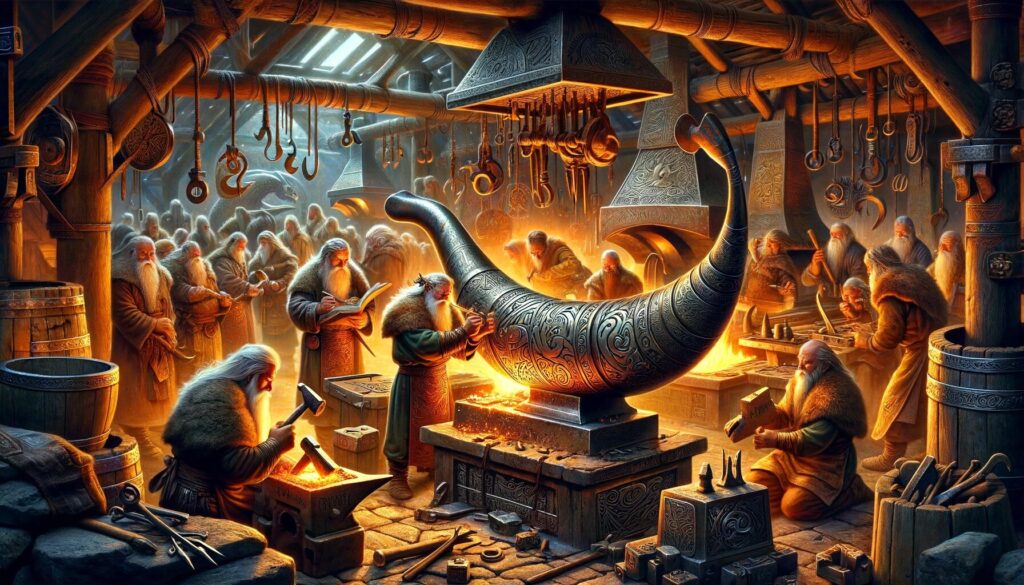Dwarves, Gjallarhorn, Loki, Norse Mythology, Norse Symbols, Tales of the Gods
The Craftsmanship of Myth: Making of the Gjallarhorn
Introduction
The Gjallarhorn, a mythical Norse horn, is shrouded in mystery and legend. It is often depicted as a powerful instrument with the ability to signal the onset of Ragnarök, the end of the world in Norse mythology. The horn’s creation is a tale of divine craftsmanship, magic, and blending myth and reality. In this article, we will delve into the intricate details of the making of the Gjallarhorn, exploring the materials, methods, and the rich history behind this iconic artifact.
Origins of the Gjallarhorn
The Gjallarhorn has its roots in Norse mythology, where it is closely associated with the god Heimdallr. Heimdallr is the guardian of the Bifröst, a rainbow bridge connecting the realm of the gods, Asgard, with Midgard, the world of humans. According to legend, Heimdallr will sound the Gjallarhorn to signal the onset of Ragnarök, a cataclysmic event that will bring about the end of the world.
Materials and Craftsmanship
The Divine Source of Materials
In Norse mythology, it is said that the Gjallarhorn was crafted from the finest materials available in the realm of the gods. The horn’s core is believed to be made from the precious metal, “Ysag,” which is said to be as resilient as steel but as light as a feather. Ysag was believed to be a gift from the gods themselves, and its exact nature remains a subject of speculation among scholars and enthusiasts.
The Crafting Process
The crafting of the Gjallarhorn was no ordinary endeavor. According to myth, it was created by the dwarven brothers Sindri (also known as Eitri) and Brokkr. These master blacksmiths were renowned for their exceptional skills in crafting divine artifacts. To create the Gjallarhorn, they undertook a complex and magical process.
- The Molding of the Core: The first step involved the shaping of the Ysag core. Sindri and Brokkr used their unmatched blacksmithing abilities to forge the core into a long and elegant horn shape. The Ysag core, when transformed, possessed an otherworldly beauty that radiated with divine power.
- The Enchantments: To imbue the Gjallarhorn with its mythical abilities, the brothers enlisted the help of the god Loki. Loki, known for his cunning and mischief, played a pivotal role in enchanting the horn. With the aid of his magic, the Gjallarhorn gained the ability to produce a sound that could be heard throughout the cosmos, signaling the impending doom of Ragnarök.
- The Aesthetic Details: The brothers paid meticulous attention to the Gjallarhorn’s aesthetic details. They adorned it with intricate patterns, runes, and gemstones, further enhancing its mystical aura.
The Secrets of the Sound
One of the most remarkable aspects of the Gjallarhorn is its sound. According to Norse mythology, the horn’s sound is said to be so powerful that it can be heard in all the realms, even reaching the ears of the gods themselves. The secret to this incredible sound lies in the craftsmanship and enchantments placed upon the horn.
The resonance chamber inside the horn was designed with mathematical precision, allowing it to amplify sound waves to an extraordinary degree. Additionally, Loki’s enchantments bestowed upon the Gjallarhorn the ability to transcend the limits of ordinary sound, making it a truly supernatural instrument.
The Role of Loki
The Mythical Role of the Gjallarhorn
The Gjallarhorn is more than just a divine instrument; it plays a pivotal role in Norse mythology.
Signaling Ragnarök
The primary purpose of the Gjallarhorn is to announce the arrival of Ragnarök. It is prophesied that when Heimdallr sounds the horn, the final battle between the forces of good and evil will begin. This event will lead to the ultimate destruction of the cosmos, followed by its rebirth.
Guardianship of the Bifröst
In addition to its role in the end times, the Gjallarhorn also serves as a means of communication between Heimdallr and his fellow gods. Heimdallr uses the horn to signal the arrival of important visitors to Asgard, alerting the gods to the presence of potential threats or allies.
The Gjallarhorn’s Cultural Impact
Legacy and Symbolism
The Gjallarhorn has left an indelible mark on Norse mythology and culture. It has also found its way into contemporary popular culture and symbolism.
Influence on Art and Literature
The Gjallarhorn’s mythical significance has inspired countless works of art, literature, and music. From epic sagas to modern novels, this horn has become an enduring symbol of impending doom and the eternal cycle of creation and destruction.
Modern Interpretations
In the modern world, the Gjallarhorn is often used as a symbol of warning or alarm. Its association with the end of the world and the idea of sounding the alarm in times of crisis has made it a potent symbol in various contexts.
Pop Culture References
The Gjallarhorn has also made appearances in popular culture, particularly in video games, where it is often depicted as a powerful and mystical artifact. In the game Destiny, for example, the Gjallarhorn is a legendary rocket launcher with devastating capabilities, paying homage to its mythological roots.
Conclusion
The craftsmanship of the Gjallarhorn is a testament to the rich tapestry of Norse mythology. Its creation involved divine materials, masterful craftsmanship, and powerful enchantments, resulting in an instrument that transcends the boundaries of reality. While it remains a symbol of impending doom and the cyclical nature of existence, it has also found its place in modern culture, serving as a reminder of the enduring power of myth and legend. The Gjallarhorn’s haunting sound continues to echo through the ages, ensuring that its story will live on for generations to come.

